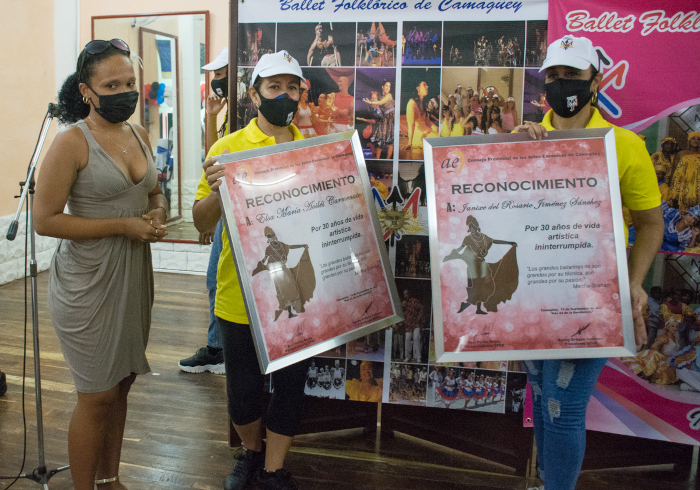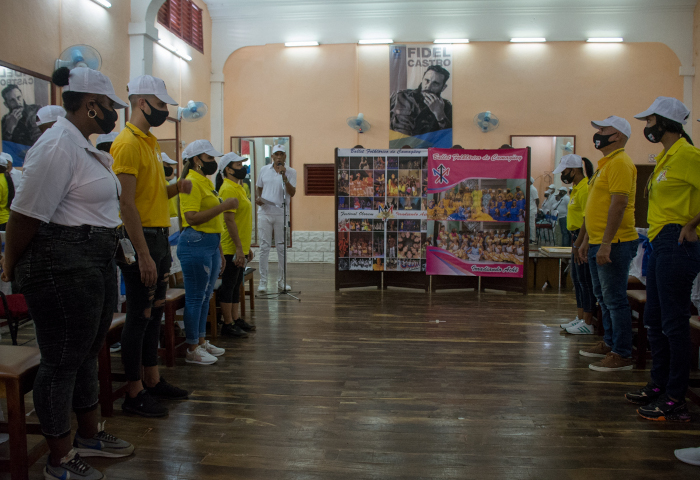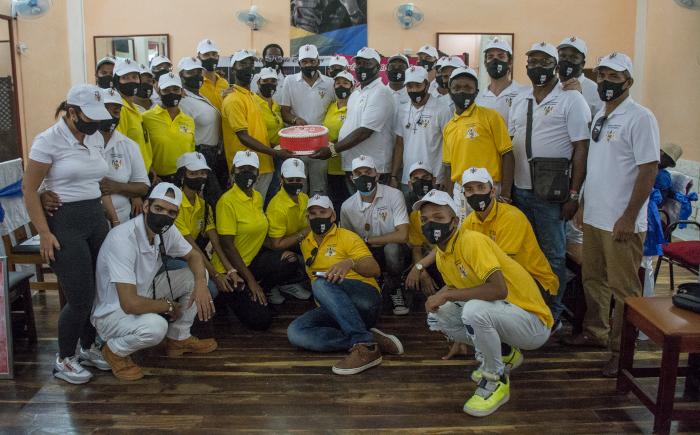CAMAGÜEY.- Members of the Folkloric Ballet of Camagüey and authorities of the institutional system of Culture in the province celebrated the company's 30th anniversary on last September 12 at its renovated headquarters.
Director Reinaldo Echemendía Estrada affirmed that learning has gone beyond dance, music and the stage, due to the intention of "representing in art what emanates from a people rich in tradition, in wisdom."
He considered the company a result of "the social justice of a country" that ponders "the worth of the barefoot on the stage", and sent special congratulations to the dance teacher Dalia Aguilar, co-founder.
The first dancers Elsa Avilés and Janixe Jiménez, and the percussionist Francisco Mola, founders who are still active there, also deserved praise.
The group obtained Recognitions from the Provincial Directorate of Culture and the Council of Performing Arts. Both instances ratified the support to achieve the Olorum Festival in December as part of the anniversary day.

PLAY THE STEPS OF A FOUNDER
His name is Francisco Eustaquio Mola Fernández, but they know him as Frank Mola. Percussionist of the Folkloric Ballet of Camagüey, he has a history of identity, of family, like the company itself because he is one of the founders, and that's where he started dancing.
“In 1991 he lived in Esmeralda. My sister Regla Mola, a dance teacher, told me that they were looking for members to create a group. I passed the auditions at the Tasende Theater. We started with 21 people”, he tells without offering many details, out of modesty.
—What did you dance in those beginnings?
—I remember the Enpungo Malungo choreography. That means The King of the Mountain. I interpreted it with María Sosa. She represented the mountain and I, the runaway slave. As a soloist I danced for Ogun, Columbia, Congo, and I joined the troupe.
When mentioning the idea of the group, it is inevitable to remember it with the hype at that closing moment in which musicians and dancers come out to meet the public with a choir, a mirror of tradition: Today I greet you/ I, the Charanga de Camagüey…
“I come from a family of Rumba’s players. My uncle Luis Mariano Almanza Varela, better known as “Fila”, directed the Charanga de Camagüey. My dad played and I started there when I was fourteen. Music is in my blood”, he says with healthy pride.
—So you have played in a few Sanjuanes…
—For as long as I can remember, I've been to the comparsa Las Estrellas, my uncle Fila's rumba, and on September 20 I'll be 56 years old... In San Juan I really enjoy how the people have fun when a charanga comes out.
Frank Mola feels more comfortable, and recounts the festive atmosphere when people went out according to the rumba group, for example, those from the Charanga del Anoncillo were looking for segments of a bush; the one with the Chancleta wore a towel, a hat and wooden shoes; Marquesano's was different.
“In recent editions, Maestro Echemendía asked me for support in the Paseo Commission”, he comments on that other complex task, and also takes the opportunity to thank his director at “Folkloric Ballet”.
“I bristle to learn that I am a percussionist of the Folkloric Ballet of Camagüey. I am empirical and I have touched things that I never imagined. The teacher tells us that the good musician dedicates time to the instrument. In the midst of a pandemic, if you don't exercise, you can't play. Your hands can hurt,” he notes.

—When did you decide to change from dance to music?
—In '96 I took my first steps as a musician without giving up dance, and in '97 I reached my evaluation as a top-level percussionist until today. Due to mishaps I have gone in and out, but my heart has always been here.
The dialogue becomes a coming and going from the present to the past. Then he takes from the trunk of memories, his experiences as an art instructor, and later as a member of Eddy Nagüe's group Guatoco Cunancheto.
“I represented the province in Para bailar three times. I got two second places. I couldn't participate in the semester because my partner had a health situation”, that's how the dance returns to the conversation.
—In the beginning, how did the public receive what you offered?
—I had an explosiveness that impressed. I danced with a real machete. I do not forget the farewell of a hotel. I had to play the Congo. Behind the tourists, I did a lap that everyone applauded. In Santa Lucía we made a life until the professor decided to return. Camagüey had to meet us in different scenarios, for today's achievements.
From there, he undertakes a tour to remember the reception in countries of Europe, America and Africa where they felt the most famous, and pleased with dances with Cuban music at the end of the shows.
“The Folkloric Ballet of Camagüey brings to the stage the spirituality of the human being. It has an identity, its own roots, songs, dances, choreographies, with live music. That differentiates us”, emphasizes this man of rhythms that go from the guaracha to the danzón, that goes from the contradanza to the peasant, and that knows how to express the magical sound of the batá drum.

He is joined by reasons for celebration: the anniversary of the company, his birthday and the return home of his wife Maidelis Yamilka Marshall López, a nurse with the Henry Reeve Brigade. Here she works as Head of the Transplant Room at the Manuel Ascunce Domenech Provincial Hospital.
“She has just returned from Azerbaijan. Before that, she served a mission in Haiti. During the pandemic she has gone as a reinforcement to other Cuban provinces. I am very grateful to my wife and my six daughters because they give me strength”, and said like that, there is no doubt that Frank Mola is a complete Camagüey´s son.
Translated by Linet Acuña Quilez



